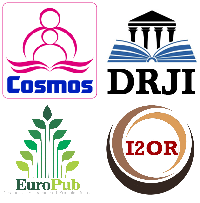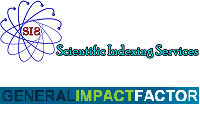Investigation of Fungal Degradation Efficiency on Spent Engine Oil
Abstract
The contamination of soil by spent engine oil is on the increase due to increased use of engines that use petroleum products. This study was aimed to investigate the biodegradation of spent engine oil using indigenous fungi isolated from soil samples. Engine oil contaminated soil was collected from two mechanic workshops located around Alex Ekwueme Federal University Ndufu-Alike. From the collected samples indigenous fungi were isolated using Sabouraud Dextrose Agar. A total of thirty isolates (100%) were isolated among which Aspergillus sp (60%) and Penicillium sp (30%) were found to be predominant. Morphological studies of the fungal isolates showed different growth patterns. Screening of the isolates for biodegradation potential was done using the Minimal Salt Medium, where six (20%) of the fungal isolates that passed the screening test were used. Biodegradation study was conducted for 15 days, isolates of Aspergillus CA4(2), Penicillium CB3(1), and Penicillium CA2(2) had a percentage rate of degradation of 78.9%, 72.1% and 65.9% respectively, while the isolate of Aspergillus CB3(3) recorded the least at 34.9%. The GC-MS result showed loss of hydrocarbons compound from the residual degraded oil and a 100% removal of pentadecane. The result revealed that the fungal isolates indigenous to contaminated engine oil sites have the potential to breakdown hydrocarbons, which makes them potent organisms for environmental cleanup.
References
Adongbede, E. M., & Sanni, R.O. (2014). Biodegradation of Engine Oil by Agaricus campestris (An White Rot Fungus). J Bioremed Biodeg, 5, 262.
Al-Hawash, A. B, Alkooranee J. T., & Zhang X. (2018). Fungal degradation of polycyclic aromatic hydrocarbons fungal degradation of polycyclic aromatic hydrocarbons. Egypt J Aqua Res, 2018, 71-76.
Ali, S. S., Elsamahy, T., Koutra, E., Kornaros, M., El-Sheekh, M., Abdelkarim, E. A., ... & Sun, J. (2021). Degradation of conventional plastic wastes in the environment: A review on current status of knowledge and future perspectives of disposal. Science of the Total Environment, 771, 144719.
Asemoloye, M. D., Tosi, S., Daccò, C., Wang, X., Xu, S., Marchisio, M.A., Gao, W., & Jonathan, S. G. (2020). Hydrocarbon degradation and enzyme activities of Aspergillus oryzae and Mucor irregularis isolated from Nigerian crude oil-polluted sites. Microorganisms, 8(12), 1–19.
Azubuike, C. C., Chikere, C. B., & Okpokwasili, G. C. (2016). Bioremediation techniques–classification based on site of application: principles, advantages, limitations and prospects. World Journal of Microbiology and Biotechnology, 32, 1-18.
Barnes, N. M., V.B. Khodse, V.B., Lotlikar, N.P., Meena, R.M., & Damare, S. R. (2018). Bioremediation potential of hydrocarbon-utilizing fungi from select marine niches of India. 3 Biotech, 8, 21.
Batelle, C. D. (2000). Environmental Science and Technology, 13, 416–423.
Behera, B. K., Varma, A., Behera, B. K., & Varma, A. (2019). Gasoline-Like Biofuel. In Bioenergy for Sustainability and Security (pp. 79-158). Capital Publishing Company and Springer Nature.
Bennet, J.W. Wunch, K.G., & Faison, B.D. (2002). Use of fungi in biodegradation. In Environ. Microbiol (2nd ed.). ASM Press, Washingt. DC.
Bharathi, B. (2019). Biodegradation of Crude Oil Contaminated Soil by Microbial Inoculants. Lulu. com.
Deshmukh, R., Khardenavis, A. A., & Purohit, H. J. (2016). Diverse metabolic capacities of fungi for bioremediation. Indian journal of microbiology, 56, 247-264.
dos Santos, E. O., da Rosa, C. C., dos Passos, C. T., Sanzo, A. V. L., Burkert, J. F. D. M., Kalil, S. J., & Burkert, C. A. V. (2008). Pre-screening of filamentous fungi isolated from a contaminated site in Southern Brazil for bioaugmentation purposes. African Journal of Biotechnology, 7(9), 1314–1317.
Elemba, M., Ijah, U. J. J., & Nneka, G. O. J. (2019). Production and characterization of biosurfactants by isolates from lubricating oil polluted soil. International Journal of Advances in Scientific Research and Engineering, 5(11), 185-194.
Fayeulle, A., Veignie, E., Schroll, R., Munch, J.C., & Rafin, C. (2019). PAH biodegradation by telluric saprotrophic fungi isolated from aged PAH-contaminated soils in mineral medium and historically contaminated soil microcosms. Journal of Soils Sediments, 19, 3056–3067.
Fulekar, M. H., Pathak, B., Fulekar, J., & Godambe, T. (2012). Bioremediation of organic pollutants using Phanerochaete chrysosporium. In Fungi as bioremediators (pp. 135-157). Berlin, Heidelberg: Springer Berlin Heidelberg.
Gargouri, B., Mhiri, N., Karray, F., Aloui, F., & Sayadi, S. (2015). Isolation and characterization of hydrocarbon‐degrading yeast strains from petroleum contaminated industrial wastewater. BioMed Research International, 2015(1), 929424.
Gavrilescu, M. (2021). Water, soil, and plants interactions in a threatened environment. Water, 13(19), 2746.
Godoy, P., Reina, R., Calderón, A., Wittich, R-M., García-Romera, I., & Aranda, E. (2016). Exploring the potential of fungi isolated from PAH-polluted soil as a source of xenobiotics degrading fungi, Environ. Sci. Pollut. Res., 23, 20985–20996.
Hussain, I., Puschenreiter, M., Gerhard, S., Sani, S.G.A.S., & Reichenauer, T.G. (2019). Differentiation between physical and chemical effects of oil presence in freshly spiked soil during rhizoremediation trial, Environ. Sci. Pollut. Res, 26, 18451–18464.
Kumar, V., Kumar, H., Vishal, V., & Lal, S. (2023). Studies on the morphology, phylogeny, and bioremediation potential of Penicillium citrinum and Paecilomyces variotii (Eurotiales) from oil-contaminated areas. Archives of Microbiology, 205(1), 50.
Maddela, N.R., Scalvenzi, L., Pérez, M., Montero, C., & Gooty, J.M. (2016). Efficiency of indigenous filamentous fungi for biodegradation of petroleum hydrocarbons in medium and soil: laboratory study from Ecuador. Bull. Environ. Contam. Toxicol., 95, 385–394.
Mahmud, T., Sabo, I. A., & Isa, S. (2020). Roles and applications of bacteria in petroleum industry: a review. Dutse Journal of Pure and Applied Sciences, 6(3), 198-214.
Medaura, M. C., Guivernau, M., Moreno-Ventas, X., Prenafeta-Boldú, F. X., & Viñas, M. (2021). Bioaugmentation of native fungi, an efficient strategy for the bioremediation of an aged industrially polluted soil with heavy hydrocarbons. Frontiers in Microbiology, 12, 626436.
Méndez-Líter, J. A., de Eugenio, L. I., Nieto-Domínguez, M., Prieto, A., & Martínez, M. J. (2021). Hemicellulases from Penicillium and Talaromyces for lignocellulosic biomass valorization: A review. Bioresource Technology, 324, 124623.
Ossai, I. C., Ahmed, A., Hassan, A., & Hamid, F. S. (2020). Remediation of soil and water contaminated with petroleum hydrocarbon: A review. Environmental Technology & Innovation, 17, 100526.
Pérez-Hernández, I., Ochoa-Gaona, S., Adams, R. H., Rivera-Cruz, M. C., Pérez-Hernández, V., Jarquín-Sánchez, A., ... & Martínez-Zurimendi, P. (2017). Growth of four tropical tree species in petroleum-contaminated soil and effects of crude oil contamination. Environmental Science and Pollution Research, 24, 1769-1783.
Ramadass, K., Megharaj, M., Venkateswarlu, K., & Naidu, R. (2015). Ecological implications of motor oil pollution: earthworm survival and soil health. Soil Biology and Biochemistry, 85, 72-81.
Ritz, k., & Young, I. M. (2004). Interactions between soil structure and fungi. Mycologist, 18, 52–59.
Roy, A.S., Baruah, R., Borah, M., Singh, A. K., Boruah, H.P.D., Saikia, N., Deka, N., Dutta, N., & Bora, T.C. (2014). Bioremediation potential of native hydrocarbon degrading bacterial strains in crude oil contaminated soil under microcosm study. International Journal of Biodeterioration and Biodegradation, 94, 79–89.
Singh Arora, D., & Kumar Sharma, R. (2010). Ligninolytic fungal laccases and their biotechnological applications. Applied Biochemistry and Biotechnology, 160, 1760-1788.
Thenmozhi, R., Arumugam, K., Nagasathya, A., Thajuddin, N., & Paneerselvam, A. (2013). Studies on mycoremediation of used engine oil contaminated soil samples. Adv Appl Sci Res, 4(2), 110-118.
Victor-Ekwebelem, M. O., Udeme Joshua Josiah IJAH, Olabisi Peter ABIOYE and Yahaya Baba ALKALI. (2020). Physicochemical and Microbiological properties of soil in Ahoko: A Suspected Petroleum Bearing Site (SPBS). Scientific Research Journal (SCIRJ), VIII(V), 15-31.
Watanabe, T., (2002). Pictorial atlas of soil and used fungi: morphology and key to species (2nd ed.). India. CRC Press.
Wu, Y., Luo, Y., Zou, D., Ni, J., Liu, W., Teng, Y., & Li, Z. (2008). Bioremediation of polycyclic aromatic hydrocarbons contaminated soil with Monilinia sp.: degradation and microbial community analysis. Biodegradation, 19, 247-257.
Xiaoqiang, T., Huang, G., Zhang, M., & Jinping, H. A. N. (2009). Compositional characteristics and geochemical significance of n-alkanes in process of crude oil cracking. Earth Science Frontiers, 16(6), 372-378.
Copyright (c) 2025 Munachimso Odenakachi VICTOR-EKWEBELEM, Nwigwe Leonard Chinedu, Oluwatosin Oluwatoyin KELECHI-MATHEW, Ursula Chidimma OHANU, Adebayo Elisha OYEWUMI

This work is licensed under a Creative Commons Attribution 4.0 International License.


 ISSN
ISSN 











